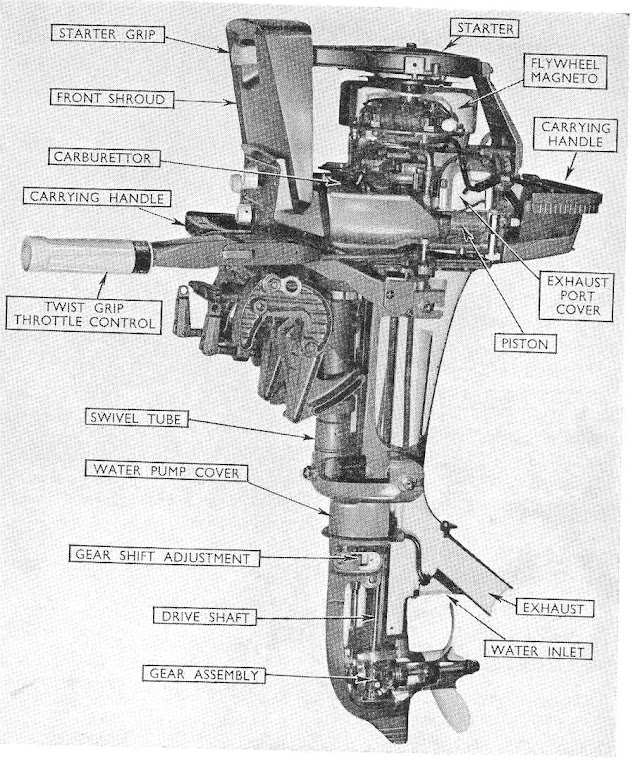General uses
Outboard motors for a boat are developed as a self-contained unit with engine, subsidiary systems, and propeller, designed to be mounted at the stern (rear) of the craft. They are the most common motorized method of propelling small watercraft.
As well as providing propulsion, outboards provide steering control, as they are designed to pivot over their mountings and thus control the orientation of the propeller. The transmission leg in the water also acts as a rudder even when the propeller is not providing power.
When boats are out of service or being drawn through shallow waters, outboard motors can also be tipped forward trimmed up over their mounts to elevate the propeller and transmission shaft out of the water to avoid accumulation of seaweed or hitting underwater hazards such as rocks.
Types of motors
The smallest of outboard motors are truly self-contained, with integral fuel tanks and controls mounted on the body of the motor and steered by a "tiller" directly connected to the motor. Such small motors can weigh as little as 12 kilograms (approximately 26 pounds) and provide sufficient power to move a small dinghy at around 8 kts (15 km/h or 9 mph), far faster than possible with oars. They are highly portable, able to be removed by simply loosening their mounting clamps. Small outboards typically use a manual pull start ignition system while larger models often have electric start similar to a car.
Manufacturers have produced large outboard designs, with sufficient power to be used on boats with lengths of 38 feet or longer. The most powerful are Inline-6 and V-8 cylinder blocks rated up to 350 hp.[1]
Manufacturers also produce electric outboards, commonly referred to as "trolling motors", which are used on very small craft or on small lakes where gasoline motors are prohibited, as a secondary means of propulsion on larger craft, and as repositioning thrusters while fishing for bass and other freshwater species in the US, where their quietness and zero emissions outweigh the range deficiencies shared with electric cars. Diesel outboards are also available, but their weight and cost make them impractical for most purposes. An additional issue with diesel outboards is toxic exhaust emissions.
Pump-jet propulsion (replacing the conventional propeller) is available as an option on most outboard motors. Like other types of pump-jet propulsion systems, they offer virtually no cavitation, giving the boat more maneuverability and the ability to operate in very shallow water. However, the low efficiency compared to propellers has seen them restricted to specialized applications.
History and developments
The idea of the outboard was a natural evolution of the canoe. One-off steam designs appeared in the late 19th century in America. While the advent of the two cycle motorbike gas engine created new possibilities. The Waterford outboard engine appears to be the first real, gas outboard that was for sale. Starting with two dozen which were made in 1907, the company went on to make thousands of the units in the next 5 years. The inboard boat motor firm of Caille Motor Company of Detroit were instrumental in making the cylinder and engines. The creation of the first practical and marketable outboard motor is often credited to Norwegian-American inventor Ole Evinrude in 1909. Between 1909 and 1912 Evinrude made thousands of his outboards and the three horse units were sold around the world. His Evinrude Outboard Co. was spun off to other owners, and he went onto success with ELTO. The 1920s were the first highwater mark for the outboard with Evinrude, Johnson, ELTO, Atwater Lockwood and dozens of other makers in the field.
Historically, a majority of outboards have been two-stroke powerheads fitted with a carburetor due to the design's inherent simplicity, reliability, low cost and light weight. On the negative side of the balance sheet, conventional two-stroke outboards are notorious polluters due to the high volume of unburned hydrocarbons (unburned gasoline/petrol) in their exhaust. They are also loud as anyone near a leafblower knows.
In the 1990s US and European exhaust emissions regulations led to the proliferation of four-stroke outboards. Though fewer in number, four-stroke outboards have always been available. For example Honda Marine has been marketing small four-stroke outboards since the early 70s. Other brands have been produced for over a 100 years, but again in fewer numbers.
Mercury Marine, Mercury Racing, Honda Marine, Suzuki Marine, and Yamaha Marine,China Oshen-Hyfong marine have all developed new four-stroke engines. Some are carbureted, usually the smaller engines. The balance are electronically fuel-injected. Some models benefit from variable camshaft timing, and multiple valves per cylinder. Mercury Verado four-strokes are unique in that they are supercharged.
Mercury Marine, Mercury Racing, Tohatsu, Yamaha Marine, Nissan and Evinrude each developed computer-controlled Direct-Injected two-stroke engines. Each brand boasts a different method of DI. Fuel economy on both direct injected and four-stroke outboards measures from a 10 percent to 80 percent improvement, compared with conventional two-strokes. Depending on rpm and load at cruising speeds figure on about a 30 percent mileage improvement.[2]
Outboard motors benefit from the ability to draw coolant from the water, obliviating the need for radiators and cooling fans, thereby simplifying the design and lowering component weight.
://: Untuk maklumat lanjut sila klik disini.



